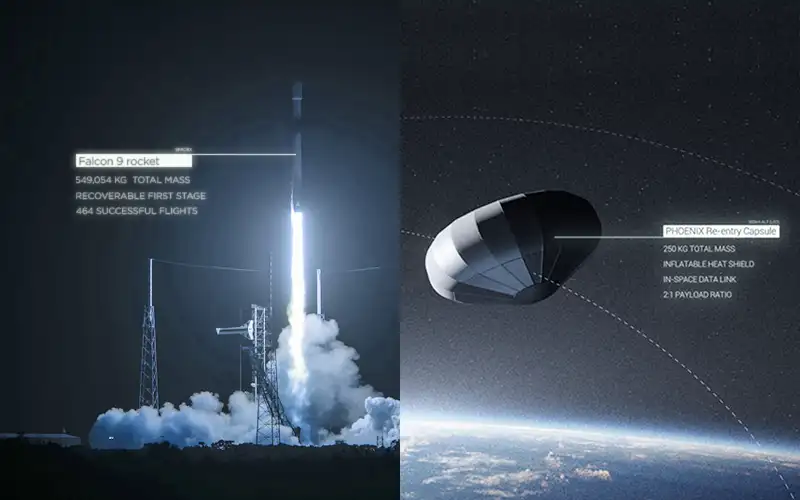
German space logistics company ATMOS Space Cargo has tentatively declared the inaugural flight of its PHOENIX 1 re-entry capsule a success, despite not yet completing a full analysis of the data collected during the mission.
ATMOS Space Cargo was founded in 2021 with the aim of developing a recoverable in-orbit research capsule called PHOENIX. The capsule is designed to carry up to 100 kilograms to low Earth orbit for missions lasting up to three months. Once its mission has been completed, the capsule will utilize an inflatable heat shield to re-enter the atmosphere for recovery.
An initial prototype of the PHOENIX capsule, called PHOENIX 1, was launched aboard the SpaceX Falcon 9 Bandwagon-3 rideshare mission at 00:48 CET on 22 April from Cape Canaveral Space Force Station. Approximately two hours after liftoff, the capsule re-entered the atmosphere, and a splashdown was expected to occur 30 minutes later.
While the company stated that it had not yet completed an analysis of all the data it collected, it confirmed that it had successfully received data from four commercial payloads aboard the vehicle and that it had initial indications that the heat shield had been inflated successfully.
“All in all, I would say it was a very successful mission,” said ATMOS Space Cargo CEO Sebastian Klaus during a post-flight press conference.
The company had hoped to acquire data and imagery of the vehicle following re-entry from a small chase plane, but the splashdown point ended up being about 500 kilometres farther off the coast than initially anticipated. While the inclusion of this phase of the mission hinted that the company anticipated the vehicle successfully re-entering Earth’s atmosphere, it’s not clear that it had any chance of achieving this milestone.
PHOENIX 1 was reliant on the Falcon 9 upper stage to place it on a re-entry trajectory into Earth’s atmosphere. While SpaceX had initially outlined a re-entry angle for the Bandwagon-3 mission that was within acceptable limits, a last-minute change resulted in a significantly steeper re-entry angle than anticipated. According to Klaus, this angle exceeded the design constraints of the vehicle’s heat shield, thereby reducing the likelihood of the prototype surviving re-entry. However, a successful re-entry of the vehicle was not one of the three objectives outlined by the company before the mission was launched.
The three mission objectives for the PHOENIX 1 test were to collect in-flight data from the capsule and its sub-components while in orbit, gather scientific data from customer payloads operating in low Earth orbit, and record data on the deployment and stabilisation of the inflatable heat shield during atmospheric re-entry. According to the company, the first two objectives were completed successfully, while the third has been tentatively deemed a success.
With a first mission under its belt, the company is now working toward testing an upgraded version of its capsule, called PHOENIX 2. The first test flight of this upgraded variant is expected to take place in 2026.
The main difference between the two vehicles is the propulsion system, with the upgraded capsule no longer dependent on its launch vehicle’s upper stage to complete a deorbit manoeuvre. In February, the company received a €13.1 million capital injection from the European Commission’s EIC Accelerator Programme to accelerate the development of PHOENIX 2.





Another failure deemed as success, what a shame.
Still, getting to that point and doing the test has value, and doing what they did is complex. Let’s be realistic but also fair (and kind, if it’s not much to ask).
Does this confuse anybody else?
“PHOENIX 1 was reliant on the Falcon 9 upper stage to place it on a re-entry trajectory into Earth’s atmosphere. While SpaceX had initially outlined a re-entry angle for the Bandwagon-3 mission that was within acceptable limits, a last-minute change resulted in a significantly steeper re-entry angle than anticipated.”
ATMOS didn’t allow the broadcasting of the 2nd stage manuvers/telemetey/video, so what happened and what was the “last minute change”?
Initially, the upper stage was expected to place the capsule on a return trajectory targeting a splashdown in the Indian Ocean, east of La Réunion. However, a few weeks before launch, this flight path was changed, and the capsule was instead expected to splash down approximately 2,000 km off the coast of Brazil. The revised trajectory also involved a steeper reentry angle, which subjected the heat shield to greater thermal loads than it had originally been designed to withstand. Does that help?
This is another one of those news items that raises more questions than it answers. One would think that the purpose of a return capsule is to return. Whether that was successful is not stated here, but the veiled manner of communication suggests that this is not the case. It also remains an open question why the flight profile of the Falcon was changed at the last minute so that the chance of a successful return was further reduced. If that information is correct, it does not seem to be good advertising for the Bandwagon program.
There likely won’t be a clear answer about the ultimate fate of PHOENIX 1. The data might offer some clues, but given the challenges during the final phase of the flight, a definitive conclusion seems unlikely. And while re-entry is a central capability of the PHOENIX capsule, it wasn’t one of the three primary objectives for this test mission. As for the trajectory change, it was probably just what worked best for SpaceX in terms of safely disposing of the upper stage. With a near-monopoly on the market, SpaceX has little incentive to prioritise the needs of a small rideshare customer on a mission that is unlikely to have brought in much revenue. If a customer like ATMOS wants a reliable, inexpensive ride to space, they really don’t have any other option. I hope that gives you a little clarity.